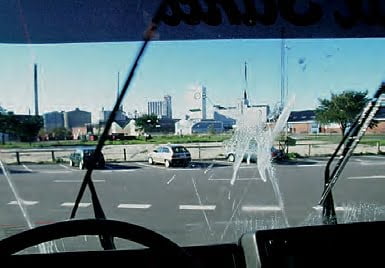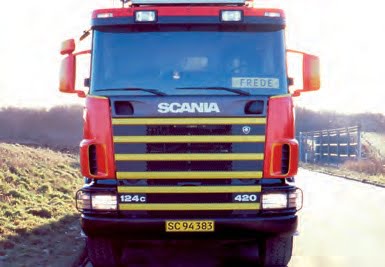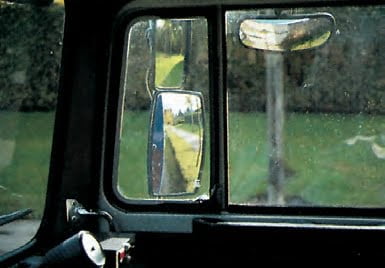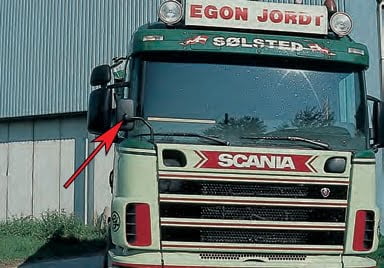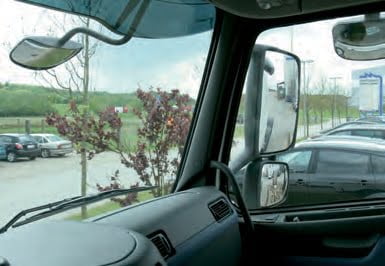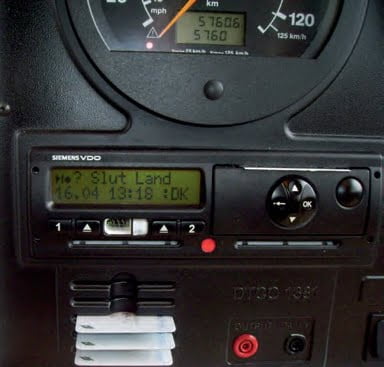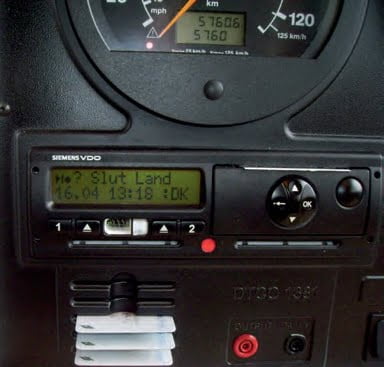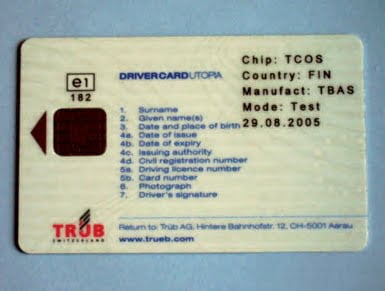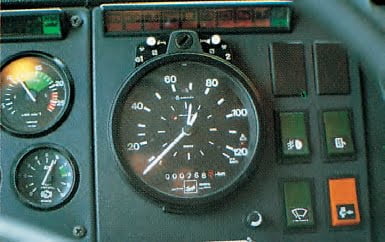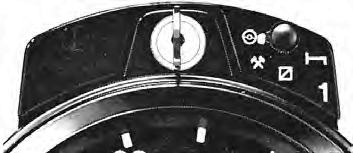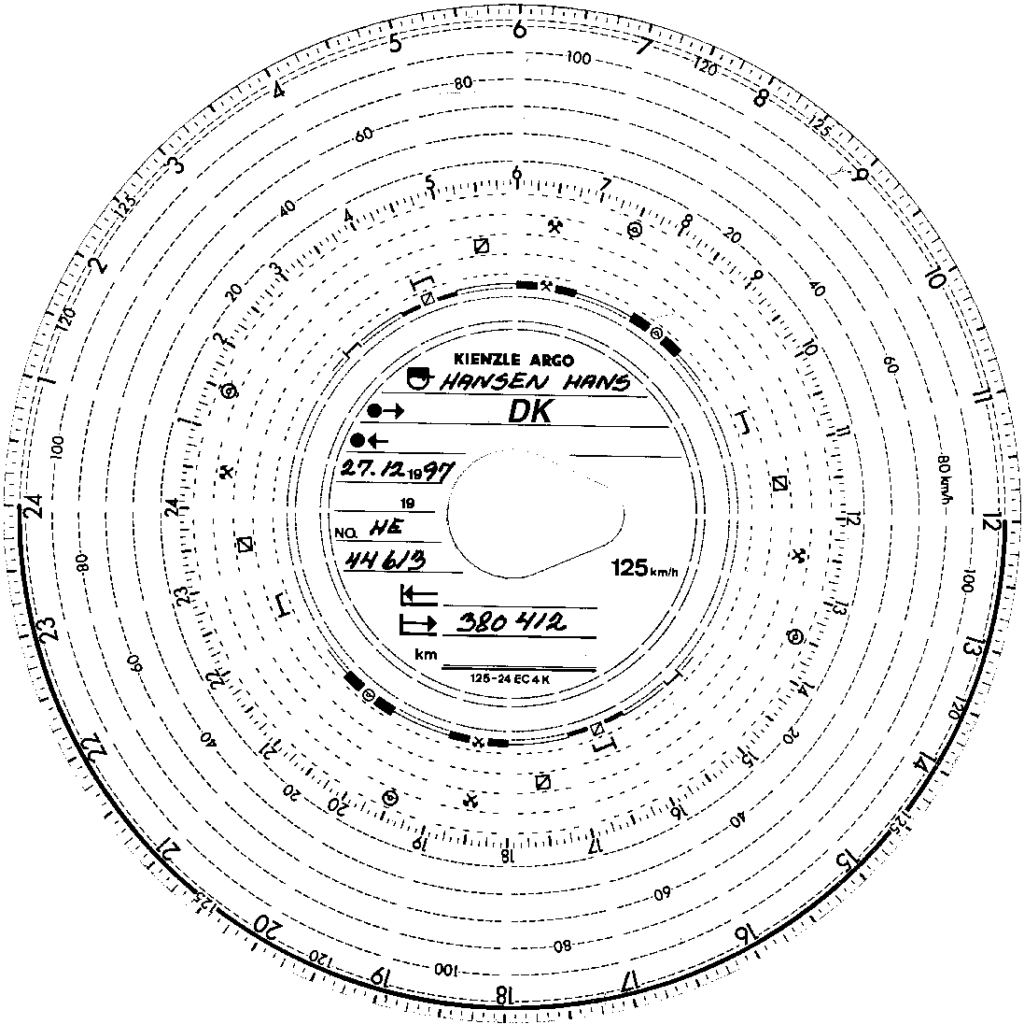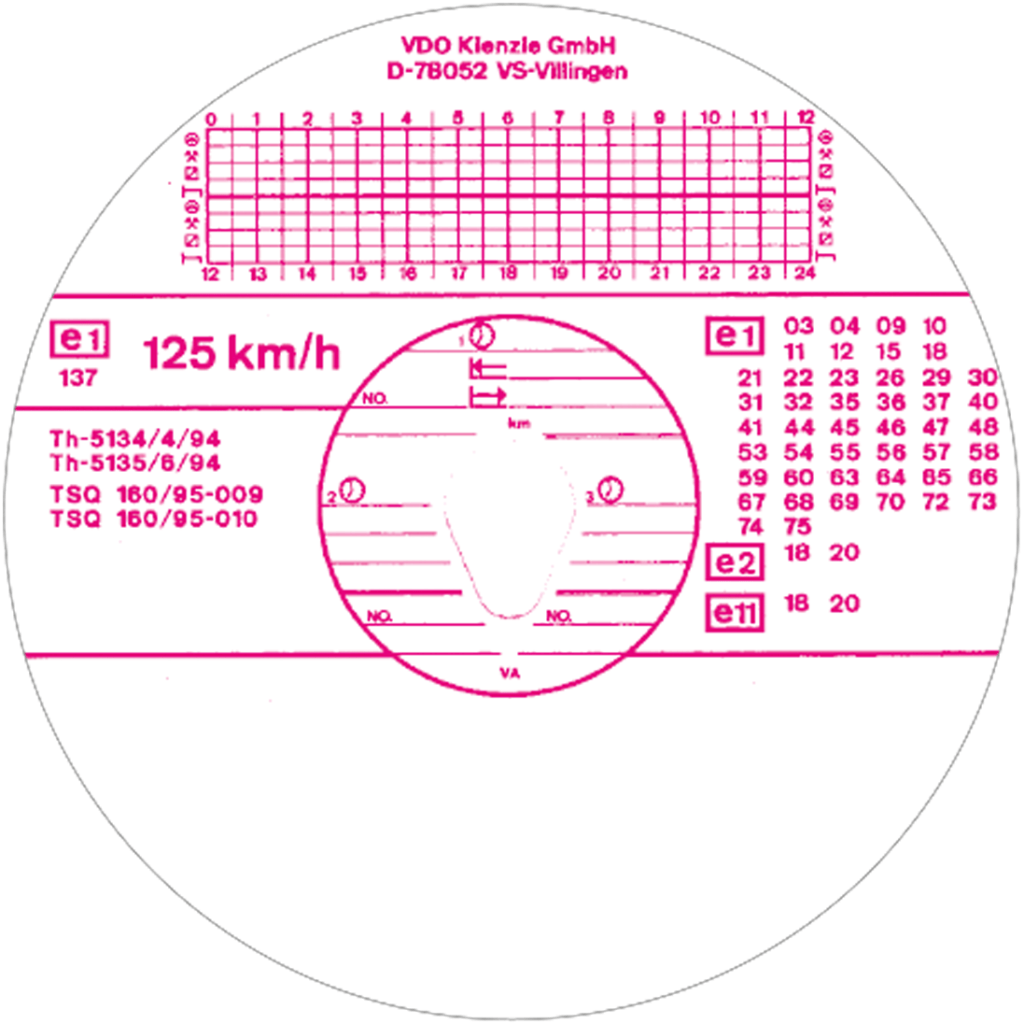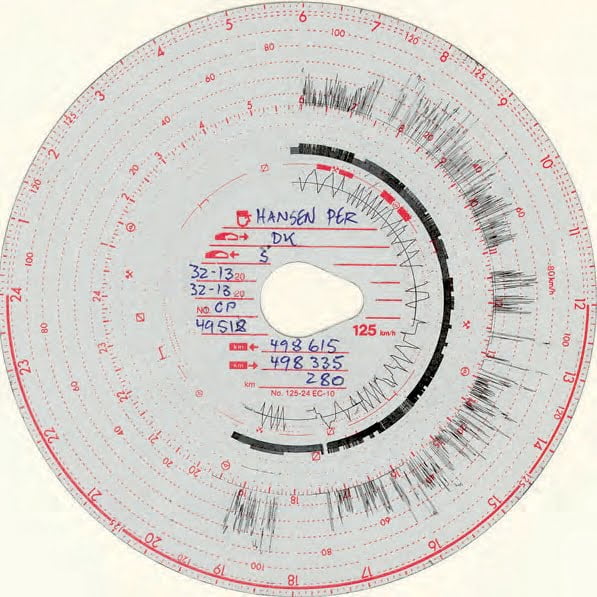large cars
Driving school
theory book
for category C - D - C/E - D/E
Large cars and lorries
8. interior layout, visibility and special equipment.
The windscreen must be able to be kept clean with wipers and washers. It must be possible to keep the windscreen free of mist and frost, e.g. with a hot air blower (defroster).
Wiper and washer must function satisfactorily. Sprinkler fluid must be filled in sufficient quantity. If the windscreen cannot be kept clean, it is a sign of a faulty wiper or washer.
There must be no loose or retrofitted objects such as wind deflectors, shelves, screens, curtains, decorations or anything else that obstructs even a small portion of the driver's view through the windscreen and side windows or the view to the mirrors.
The car must be equipped with an exterior rear-view mirror on each side.
On a bus designed to carry more than 19 passengers, it must be possible to keep the right-hand rear-view mirror free of fog when heated.
All lorries must be equipped with a rear-view mirror on both sides. In addition, on the right side there must be a wide-angle mirror and a near-zone mirror. (Both of the "new" type (with a different curvature so that the mirrors cover a larger area).
Newer lorries from 2007 onwards with a gross vehicle weight of more than 7,500 kg must also be equipped with a front mirror or camera.
A proximity mirror is only required if it can be positioned at least 2 metres above the road (exception - e.g. trucks with canvas roofs).
Blind spot mirrors (only found on older trucks) can be replaced by wide-angle and near-zone mirrors of the "new" type.
How to adjust the rear-view mirror
Adjust the rear-view mirrors on each side so that the side of the car is just visible in the inner part of the mirror and the horizon is visible in the upper part of the mirror.
How to set the close-up mirror
Close proximity mirrors must provide the driver of the truck with a view at a distance of at least 2 metres from the right side of the truck cab.
How to set the wide-angle mirror
Wide-angle mirrors, possibly supplemented by blind spot mirrors on the right side of the lorry, must provide the driver of the lorry with a view obliquely to the rear from the lorry cab.
Front mirror
Front mirrors must provide the driver of the lorry with a view immediately in front of the lorry at least 2 m from the front of the lorry and at least 2 m from the front right-hand corner of the lorry.
Blind spot mirror.
In truck workshops, larger petrol stations and weighbridges, there are often painted areas where you can check the alignment of your mirrors.
Specialised equipment
The car must be equipped with a speedometer, which is usually combined with a tachograph. Newer cars must instead be equipped with a digital tachograph (Tachograph). The recording equipment must normally be installed in lorries for goods transport (over 3500 kg) and buses. However, there are exceptions, such as emergency vehicles, school vans and refuse collection vehicles. The tachograph must function correctly. The tachograph must be inspected by an authorised workshop at least every two years. During the inspection, the installation plate in the tachograph must be replaced. The recording equipment and driver card must function correctly and be used correctly. The recording equipment must be installed correctly, tested and sealed by an authorised workshop and fitted with an installation plate. The details of the recording equipment are laid down in the Regulation of the European Parliament and of the Council on the harmonisation of certain social legislation relating to road transport and the Council Regulation on recording equipment in road transport.
General EU regulations on driving and rest periods
Drive time
- Driving time is the time recorded as driving by a recording device. Daily driving period: The total driving time between 2 rest periods. The daily driving period must not exceed 9 hours. However, it can be increased to 10 hours twice in a week.
- The weekly driving time must not exceed 56 hours.
- The sum of driving time in 2 consecutive weeks must not exceed 90 hours.
Breaks and rest periods
Drive time without a break
- A driving time without breaks must not exceed 41/2 hours, after which there must be a continuous break of at least 45 minutes, unless the driver begins a rest period.
- This break can be replaced by a break of at least 15 minutes, followed by a break of at least 30 minutes spread over the driving period. The order of the breaks cannot be swapped. For two-man operations, the break can be taken in a moving vehicle.
- The driver must not perform driving or other work during this break.
ATTENTION! Please be aware of the "Law for Mobile Workers" which stipulates the driver's working hours. The weekly working hours may not exceed 60 hours. Within a 1/2-year period, the average weekly working hours must not exceed 48 hours.
Rest time
- Within any 24-hour period after the end of the previous daily or weekly rest period, the driver must have taken a regular daily rest period of at least 11 consecutive hours (regular daily rest period).
- The regular daily rest period can be taken in 2 periods, of which the first period must be at least 3 consecutive hours and the second at least 9 consecutive hours.
- Rest time can be reduced to at least 9 consecutive hours (reduced daily rest time) up to 3 times between two weekly rest periods.
- If there are multiple drivers in the vehicle, each driver must have a daily rest period of at least 9 consecutive hours within a 30-hour period.
- A regular daily rest period taken while accompanying a vehicle on board a ferry or train shall not be interrupted more than twice by other activities for a total of not more than one hour. The driver must have access to a bunk or couchette.
- For two consecutive weeks, the driver must take at least:
- 2 regular weekly rest periods of at least 45 hours each,
or
- a regular weekly rest period of at least 45 hours and a reduced weekly rest period of at least 24 hours. The reduced time, e.g. 21 hours (regular weekly rest period of 45 hours minus reduced weekly rest period of 24 hours) must be compensated by a corresponding rest period, which must be taken in total within three weeks of the end of the week in question. - Rest taken as compensation for a reduced weekly rest period must be taken in continuation of another rest period of at least 9 hours. In the example of a reduced weekly rest period of 24 hours, the compensation must be at least 30 hours (the reduction of 21 hours plus 9 hours).
- A weekly rest period must start no later than the end of 6 consecutive 24-hour periods after the end of the previous weekly rest period.
- Daily rest periods and reduced weekly rest periods taken away from home may be taken in the vehicle if it is equipped with adequate sleeping facilities for each driver and the vehicle is stationary.
Using the control device
- The tachograph can be either analogue with a record sheet or digital with a driver card. An analogue tachograph records the driver's activities on a record sheet. A digital tachograph records the driver's activities partly in the tachograph and partly in the chip in the driver card.
- In certain special cases, such as damage or theft of the driver card, it may be necessary to use a printout from the digital tachograph to record the driver's activities.
- Chart sheets/driver cards must be used every day from the moment the vehicle is taken over until the end of the daily work period.
- If a chart sheet is used, a sheet that matches the control device must be used. This is ensured by looking at the printed numbers on the back of the chart sheet, where one number must correspond to the number on the control device's nameplate.
Before inserting the diagram sheet into the recording equipment, the driver must clearly and legibly record the following information on the sheet:
- 1. surname and first name. It is not sufficient to include initials and stamps may not be used.
- 2. Start date and start location. Start location can be specified either by country code (e.g. DK), or country (e.g. Denmark) or city name (e.g. Esbjerg).
- 3. registration number of the vehicle to be used. When changing vehicles during the work period, the registration number of each subsequent vehicle must be listed in order on the back of the sheet.
- 4. Mileage at the start time. When changing vehicles during the work period, the ending kilometres of the first vehicle must be entered on the front and the starting kilometres of the new vehicle must be entered on the back together with the new registration number.
- 5. The time of the vehicle change. The time is recorded on the back of the chart sheet.
- 6. The end date, end location and mileage must be recorded on the chart sheet when it is no longer required.
- 7. The driver must operate the recording equipment's setting buttons in such a way that all time groups (driving time, other work, availability and rest) are recorded and that the driver's activities can be clearly seen on the record sheets/data on the driver card and in the digital recording equipment, as well as on any printouts.
- 8. The chart sheet may only be replaced at the end of the daily work period. However, the chart sheet may be removed when changing vehicles or when the chart sheet
is not expected to be used again in the same vehicle. - 9. The driver card may only be withdrawn at the end of the daily work period. However, the driver card may be withdrawn when changing vehicles or when the driver card is not expected to be used further in the same vehicle.
- 10. The chart sheet may remain in the control device for a maximum of 24 hours.
- 11. Chart sheets/driver's licence and all manual records and printouts for the current day and the previous 28 days must be carried while driving and must be presented to the police upon request.
- 12. In the event of malfunction or defective functioning of the recording equipment, the driver shall record on the record sheet or on a separate sheet attached to either the record sheet or the driver card all the information that would otherwise have been recorded by the recording equipment.
Tachograph and chart sheets (discs)
Tachograph
Driving must be documented, as breaks and rest periods must be recorded. Cars that are subject to the rules on driving and rest periods must therefore be equipped with a tachograph that records on a chart disc how fast and how far the car has travelled, and when and for how long it has stopped.
Time group switch operation
At the beginning of the journey, the switch hand is set to position 11 (driving time). At the end of the journey, the pointer is set to position 11 or 11 according to the activity being started.
The chart disc is filled in as follows:
Before loading the disc:
Full name (last name - first name).
Location where the tour begins.
Date of the start of the trip.
Registration number.
Mileage at the start.
When switching to another car:
Time of car change.
Registration number.
Mileage at the end.
Mileage at the start.
The backside is also used in case of an emergency:
- Faulty tachograph.
- You leave the car.
- The reason for exceeding driving and rest times.
At the end of the work period:
Place where the tour ends.
End date of the trip.
Mileage at the end of the trip.
The driver must comply with the following provisions regarding the recording equipment and chart sheets
- Only use clean and undamaged discs.
- The control device number should be found among the printed numbers on the back of the sheet to ensure the correct chart sheet is used.
- Must use the disc every day from the moment the vehicle is taken over and for the entire period of use.
- Do not use a single disc for more than 24 hours.
- Must ensure that the time recorded is in accordance with the official time of the country in question.
Malfunctions: If the tachograph breaks down, it must be repaired. If the car is not back at home within a week, the repair must be carried out en route.
If the tachograph is broken, the driver must record driving and rest times on the back of the disc.
- For the periods when the driver has not driven or has had time off or holiday, a so-called "Holiday Declaration" (declaration for missing record sheets) must be completed. Any declaration or several, if available, must be brought along during the journey and presented as documentation, together with the record sheets and any printouts, at the request of the police. (See example of a declaration for missing diagram sheets at www.transit.dk).
Disc showing a typical working day!
A) The driver inserts the disc when taking over the vehicle (start of registration). Surname and first name are recorded, place of departure (nationality letters), vehicle registration number, date and odometer reading.
B) The pin records the day's driving (speed and any stops (loading and unloading) and any stops in traffic)
C) Break for at least 15 min. (Always taken as 1st break)
D) Break for at least 30 min. (Always taken as a second break) (The two breaks could also be taken as one combined break of at least 45 minutes). Then driving again for a total of no more than 4.5 hours. (Normally maximum driving time 9 hours per day)
E) Twice a week, you can drive one extra driving lesson. Please note that an extra break of at least 45 minutes must be taken beforehand (i.e. twice a week you can drive 10 hours).
The disc (chart sheet) is taken at the earliest at the end of working hours, at a change of vehicle or after 24 hours.
The driver records the end location, date and odometer reading and finally calculates the number of kilometres driven. (The disc is carried for the day of driving and for the previous 28 calendar days and is then handed over to the employer)
NB. If resting in the vehicle, it is recommended that a disc starts with rest (usually 11 hours). The digital tachograph records the driver's driving in the same way as the analogue tachograph.
Test your knowledge
Cat. C - D - C/E - C/E - D/E - Section 8
Select the questions you think are the right ones.
